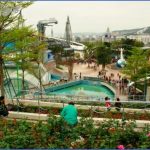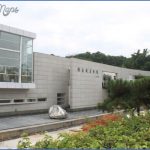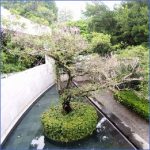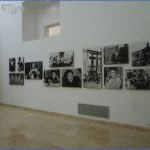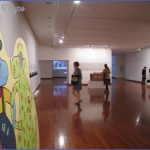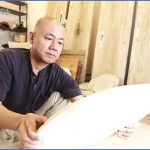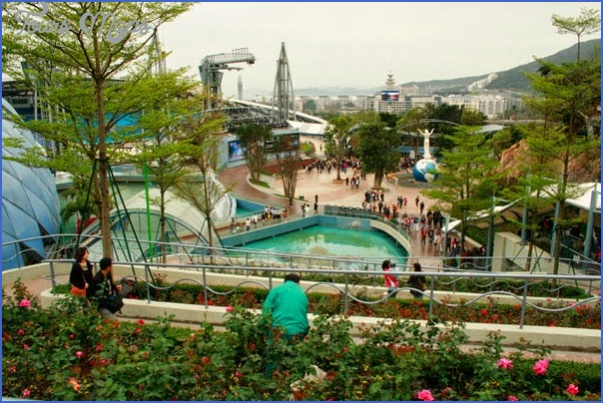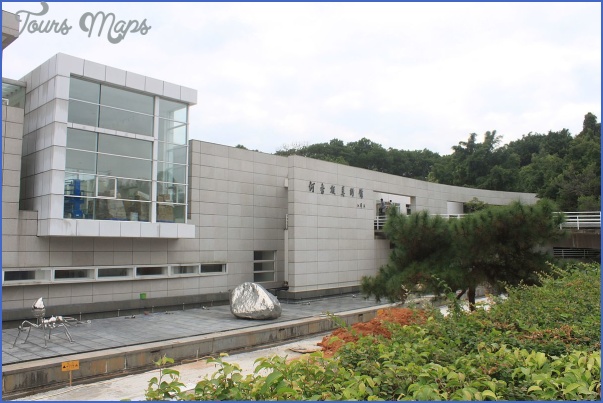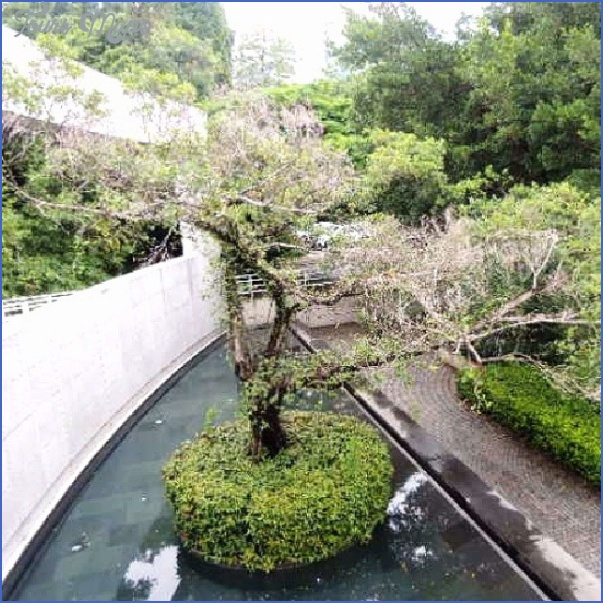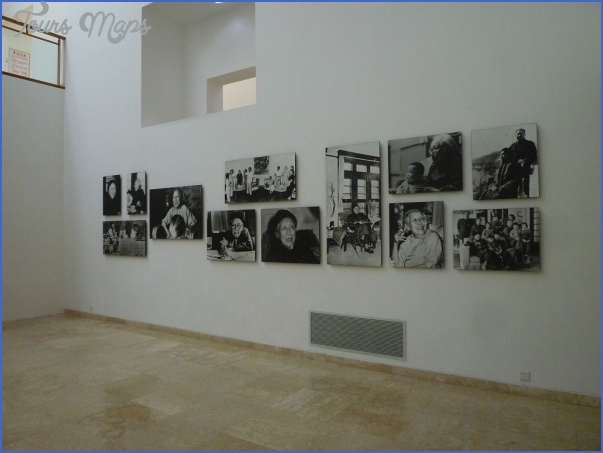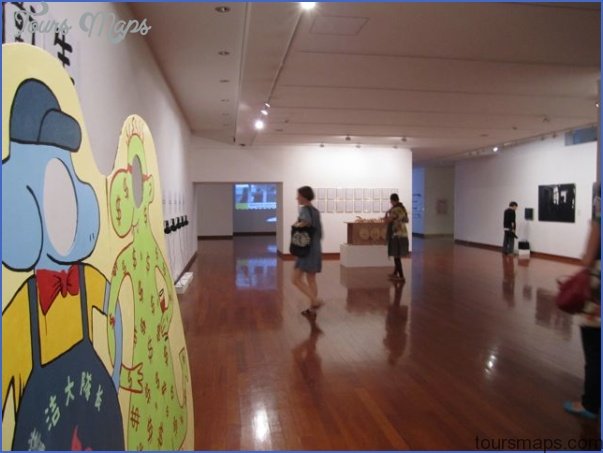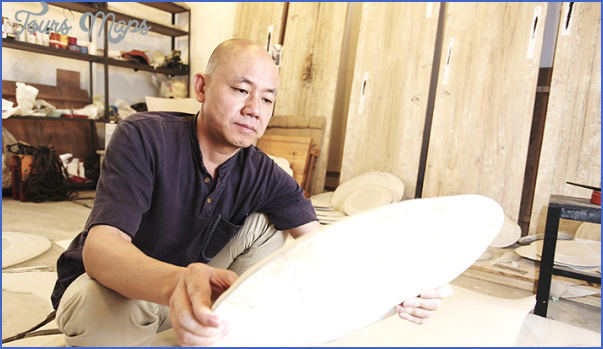Visiting this gallery is a strange experience because once again, in the name of culture, we are deep in the realm of politics.
The gallery is divided into two parts. The first exhibits and promotes avant-garde art. Of that more later. The second exhibits the art works of political heroine He Xiangning. In fact her paintings are competent but conventional amateur pieces of Chinese scroll painting, mountains, cherry blossoms, tigers and the like. This is not surprising because she took up painting after the age of fifty. Many of the paintings exhibited are not even exclusively by her. Most were done in collaboration with famous artists, with her son Liao Chengzhi, or with senior communist politicians.
The sub-text in this gallery is once again the United Front, with a possible nod to Taiwan reunification. He Xiangning 1878-1972 was the united front politician par excellence. With her husband Liao Zhongkai, she was a founder member of the KMT and in 1924 she assisted Sun Yat-sen in formulating the Three Principles of the People, the ruling ideology of the KMT. In 1926-7, the KMT Government, which at that time governed only the area around Guangdong, set out to capture the whole of China. This campaign was called the
Northern Expedition. The real power in the KMT at this time resided in the Soviet adviser Borodin, and the party itself was split between the pro-Moscow left and anti-Moscow right wings. He Xiangning was firmly of the left. When Sun Yat-sen died, it was widely expected that her husband, Liao Zhongkai, as leader of the left, would take his place as head of the KMT. These hopes were cut down with Liao on 20 August 1925 when gangsters likely answering to the Shanghai gang godfather, Du Yuesheng and to Chiang Kai-shek assassinated Liao.
When Chiang Kai-shek broke with Moscow and purged the communists in the KMT, He Xiangning remained loyal to the leftist principles enunciated by Sun after his correspondence with Stalin, namely alliance with the Soviet Union, cooperation with the Chinese Communists and reliance on the workers and peasants. She was one of the original founders of the Revolutionary Committee of the KMT.
Many people do not appreciate that when the Communists took power in 1949, they purported not to have established a communist state but a people’s democracy. This was in keeping with Marxist theory about the inevitable wheel of history evolving through different historical phases. It was not possible to have a communist revolution until there had been a bourgeois democratic revolution. That was the sort of theoretical debate, which was bread and butter to the communists of the day. It also suited Stalin to go through the charade in the new Russian Empire in East Europe that the progressive democratic forces had an active role in democratic government. Thus the new countries were People’s Democracies, not Soviet Socialist Republics.
The same was true in China. Several democratic parties were allowed to coexist with the communist party and were allowed to participate in various rubber stamp bodies including the Chinese People’s Political Consultative Committee CPPCC, the National People’s Congress NPC etc. The Revolutionary Committee of the KMT was one such party and He Xiangning was its Chairman. She was Vice-Chairman of the CPPCC, Vice-Chairman of the Standing Committee of the NPC and Honorary Chairman of the All China Women’s Federation.
The United Front had a special part to play in Overseas Chinese affairs since it was felt that a non-communist might have more appeal in this area, and she was also Chairman of the Committee of Overseas Chinese Affairs. And, as one might expect from a competent amateur artist who was also a seasoned politician, she was Chairman of the Chinese Artists Association.
There is another political dimension to the He Xiangning Gallery. We mentioned above that at the time of the foundation of the Shenzhen SEZ, different parts of the zone were farmed out to different organisations as their personal bailiwicks, and that in the case of the OCT area, that organisation was the Overseas Chinese Commission which owned the Shahe Overseas State Farm which originally covered the OCT area. As we said above, the head of the Overseas Chinese Commission and the driving force behind the development of OCT in its early days was Liao Chengzhi. And He Xiangning was his mother.
Armed with this knowledge, we found her section of the gallery fascinating. Political figures in China have a surprisingly large amount of leisure time available to them you can see this by checking the numbers of paintings which were completed in resorts such as
Beidaihe so she was a prolific artist. But she was also a politician, and one deeply dedicated to getting along with as many important people as possible. How else could she have survived as long as she did in the political minefield of China? Thus most of her works were completed in collaboration with other people.
There are three galleries. The first is of paintings painted in collaboration with famous artists. With a number of artists she formed a group called Han zhi Youren and produced several paintings with artists of the calibre of Chen Shuren, Liu Yazi, Wang Yiting etc.
The second is of paintings that she did in collaboration with her son, Liao Chengzhi. The notice in this gallery says that the mother, He Xiangning, painted the landscapes, while the son, Liao, added the figures.
The third gallery is the most interesting. He Xiangning was in the habit of cementing political friendships and alliances by making gifts of her paintings to important political figures who then wrote inscriptions on them. A number of these are exhibited in this gallery. Among the inscriptions are ones by such luminaries as Marshals Chen Yi and He Long and President Dong Biwu.
Several inscriptions by Liu Shaoqi struck us. Liu Shaoqi, then President of China, and Deng Xiaoping were the main targets of the Cultural Revolution Liu died in prison. Deng, as we know, survived. We do not know what happened to He Xiangning during the Cultural Revolution. She was already 88 when it started and we would like to think that at least a little respect was given to her age. But people died in the Cultural Revolution for much less than a personal inscription from Liu Shaoqi.
Fortunately, at the head of the gallery is exhibited a powerful talisman in the form of a letter from Mao Zedong himself. It appears that she had sent him a painting in Yan’an and he was writing to thank her for it. He writes, Your painting is full of revolutionary spirit. Although I do not understand art, I feel that it is good. He didn’t know about art but he knew what he liked. If we were her, we would have kept this small letter close to our hearts and pulled it out whenever a Red Guard approached within twenty yards of us. We are confident that she did.
Then suddenly once again we pass directly from the sublime to the ridiculous. The rest of the gallery is given over to the most avant of the avant-garde. On the day when we first visited the gallery we were fascinated by the wide-ranging nature of the displays. There were several rooms of cyber art, an exhibit based on computer games with naked figures changing colour as they dived into a square pool and re-emerged to climb to safety up a rope like Indian fakirs, a figure in a suit spanking a semi-naked woman on his lap. It didn’t seem to be quite the thing for the school kids who were operating the interactive part of it. Then there were brightly coloured frogs swimming up a wall through lotus plants. You could make the whole thing shimmer by pouring water into a clear plastic receptacle, which we proceeded to do. All of this was accompanied by the requisite arty figures with long hair and ponytails, which gave the morning a pleasant Greenwich Village 1964, feel.
The gallery building has long clean airy light lines, a sharp contrast to the strange stones and banyans of the China Folkways Village entrance next to it.
We recommend a visit to this gallery even if only for the experience of rubbing shoulders with the avant-garde. The mysteries of politics are a bonus.
Address: Shennan Ave OCT
Open 10 am to 6 pm
Bus nos. 21, 26, 54, 59, 101, 105, 109, 113, 204, 223, 338, 373, 390 Metro: Hua Qiao Cheng.
Entry is $15
Website: http://www.shenzhenparty.com/place/art-gallery/he-xiangning-art-museum
HE XIANGNING GALLERY SHENZHEN Photo Gallery
Maybe You Like Them Too
- The Best Cities To Visit in The World
- World’s 10 Best Places To Visit
- Coolest Countries in the World to Visit
- Travel to Santorini, Greece
- Map of Barbados – Holiday in Barbados

